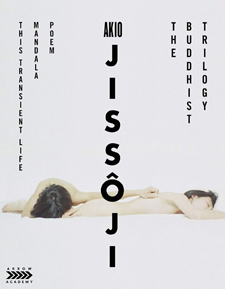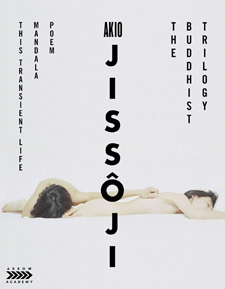Akio Jissôji: The Buddhist Trilogy (Boxset) (Blu-ray Review)

Director
Akio JissôjiRelease Date(s)
1970/1971/1972 (August 20, 2019)Studio(s)
Art Theatre Guild (ATG)/Jissôji Productions/Toho (Arrow Academy)- Film/Program Grade: See Below
- Video Grade: See Below
- Audio Grade: See Below
- Extras Grade: C+
- Overall Grade: B
Review
While western audiences are more familiar with the work of Akio Jissôji through his work on the Ultraman series, many might not be aware of his more personal film work. Gathered together for the first time on Blu-ray is what is known as The Buddhist Trilogy, which consists of three films: This Transient Life, Mandala, and Poem. Challenging and beautiful works, they highlight the New Wave of Japanese cinema as a fertile ground in which complex, idealistic, and controversial pieces of subject matter could be explored with only the finest cinematography available.
In This Transient Life (aka Mujo), a brother feels there’s more to life than tradition and favors living a monk’s life while his sister is lonely and looking for male companionship. Their father disapproves of the brother’s unorthodox ways, meanwhile attempting to push the sister into marriage. However, when the mother and father are away on a trip, an unexpected incestuous relationship begins. Attempting to keep it a secret, the brother goes to live in a monastery and aid in the carving of a statue of Buddha while the sister marries a neighbor. Tragically, their unnatural love for each other proves to be a soul-stirringly emotional task to keep hidden.
Asian cinema of the 1960s and 1970s, especially the Japanese New Wave, proved to be a highly experimental environment. While many were paying attention to the work of Kurosawa, other filmmakers were leading the pack with what would become everyday cinema for Asian audiences. This Transient Life, in particular, was a forerunner to what would become known as pink film, a softcore pornography genre that was quite lucrative in Japan for the next couple of decades. While the film features more than one extended lovemaking scene between siblings, it’s less about the sex and more about the impact of it on the characters. At the same time, we’re treated to a range of unconventional camera work, which is almost always in motion or shown from unusual but effective points of view. With a running time of nearly two and half hours, it’s an extensive piece of art with salacious elements on the surface, but deeper meaning within.
In Mandala (aka Mandara), two couples join a cult dedicated to the study of sexuality and agriculture, but through the prism of human aggression. The film throws convention out the window, even drawing viewers in with a lengthy sex scene at the beginning before getting into more philosophical and tasteless material. We witness a couple relaxing on the beach before they are attacked, with the woman subsequently raped, all under the watchful eyes of the cult leader and his disciples. Later we see a woman who claims to be a “prostitute for the gods,” giving herself over to spiritual pleasure, writhing and moaning on the floor as she is made love to by an invisible force. Meanwhile, one of the couples find themselves disillusioned by all of this, with the man in particular forced to deal with the cult’s beliefs in a dishearteningly solitary way.
Mandala has more in common with Pinky Violence or Nikkatsu Roman Porno rather than a more traditional pink film as both genres deal more with sensationalized violence and rape. On the other hand, the film spends much of its running time delving into Buddhist thought and belief. All of this is achieved through a combination of color and black-and-white cinematography, the latter of which is used to sever the connection between the cult leader and his cynical pupil. The same type of camera work is employed, including long, steady tracking shots, close-ups, and a variety of angles. It doesn’t have as much draw as its predecessor on an emotional level since the subject matter is more taboo and inelegant by comparison, but it’s executed in a gorgeous manner with strong location work, deeply-shadowed environments, and haunting images.
Presented in its theatrical and extended versions, Poem (aka Uta) tells of a family with a large stretch of forested land, owned primarily by their elder son. As he plans to sell the property to developers, the young houseboy, who is unwaveringly faithful to the family and their property, greatly disapproves of this decision. This is actually the most spiritual of the three films with its primary concern being nature in its purest form, and the undying devotion to it by the few that care. More Buddhist teachings are parted, but ultimately, it’s the toughest of the three films to get through. It’s a two-hour film (thirty minutes longer in its extended form) and much of the time is dedicated to long, lingering scenes of the houseboy performing his duties, eating, or sleeping. Fortunately, the same sophisticated cinematography is employed, and the black-and-white images offer many layers and textures, including many memorable moments indoors between characters in darkness and outdoors in natural light.
For Arrow Academy’s Akio Jissôji: The Buddhist Trilogy Blu-ray boxed set release, all of the films are sourced from high definition masters provided by Toho. The black-and-white presentations of This Transient Life and Poem are potent, though far from perfect (which adds to each film’s aesthetic). Delineation isn’t all that impressive, as blacks are so deep they’re bordering on crush (though by design, to a degree). However, grain levels are solid and there are no issues with overall brightness or contrast. Light instability is present throughout This Transient Life, as well as occasional bits of speckling. The presentation of Mandala also offers stable grain, though slightly softer images. Detail is high, particularly in daytime photography which soaks up outdoor landscapes, but falters in darker environments. Color reproduction is strong and delineation during the black-and-white segments is improved over its counterparts, though saddled with crush. Everything appears stable with only minor speckling leftover.
The audio for all three films is included in Japanese mono LPCM with subtitles provided in English SDH. Dialogue is obviously the main drive of each soundtrack, but score and sound effects play just as much of a role, coming through with high levels of energy. The elements have good separation to them, but damage is apparent at times, more so in The Transient Life than others, including light hiss, crackle, and thumps.
THIS TRANSIENT LIFE (FILM/VIDEO/AUDIO: B-/B/B-
MANDALA (FILM/VIDEO/AUDIO: C+/B+/B
POEM (FILM/VIDEO/AUDIO: C/B/B
Each film has its own dedicated disc with introductions and scene-by-scene audio commentaries by Asian cinema expert and film professor David Desser, who provides a wealth of contextual information about Akio Jissôji and his work, as well as musings on each film. The discs for Mandala and Poem also feature their respective theatrical trailer. Also included is a bonus disc containing the film It Was a Faint Dream, along with its theatrical trailer. All of this material is housed within sturdy cardboard packaging with a 60-page booklet containing cast and crew information for each film, the essays This Transient Life by Tom Mes, Mandala by Anton Bitel, Poem by Espen Bale, Akio Jissôji, Sacred and Profane by Tom Mes, and transfer information.
It would be fair to assess that the work of Akio Jissôji could be seen as impenetrable and nonsensical to outsiders. It mostly offers philosophy and beautiful images rather than traditional stories. These are art films soaking in Buddhist philosophy, and if that sort of filmmaking appeals to you, the Blu-ray release of The Buddhist Trilogy offers plenty.
– Tim Salmons

